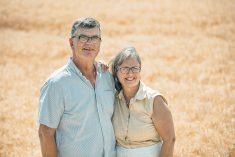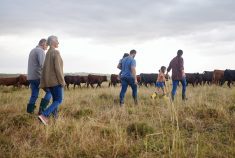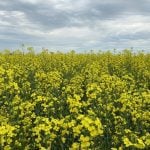In south-central Manitoba, a farmer we’ll call Ralph, 48, and his wife, who we’ll call Susie, 46, have three children ages 13, 14 and 18. Ralph and Susie want to retire in 17 years, when Ralph is 65.
The plan is for the eldest son, who we’ll call Parker, to take over the farm. It’s 2,340 acres, 1,500 owned personally by Ralph and Susie and 940 owned by the family farming corporation. Parker’s siblings would have their interests covered by profits distributed by the farming corporation to them as shareholders.
The transition from the present ownership set-up to control and ownership by Parker is complicated by hefty debts. It includes a $120,000 shareholder loan, that is, money payable by the farming corporation to the owners.
Read Also

Gentle treatments for pain in the neck
Heading toward year-end, people unknowingly tense up against the cold and busyness, causing neck pain that can often be treated with appropriate support and gentle mobility, athletic therapist Kathlyn Hossack says.
There are several ways to transition ownership from Ralph and Susie to their offspring. One is to split the farm into three units for the children but that could imperil the farm as a going concern. Therefore, the plan is to place ownership in Parker’s hands and ensure that his two siblings are treated fairly.
Colin Sabourin, a certified financial planner at Harbourfront Wealth Management in Winnipeg, came up with a strategy for Ralph and Susie. His goal — a way to pass on the farm to Parker and provide non-farming assets to his siblings.
As it turns out, there aren’t a lot of non-farm financial assets, for Ralph and Susie have reinvested their profits in the farm which, Sabourin notes, “has served them very well.” But there are solutions, Sabourin suggests. First, buy permanent life insurance on the parents’ lives while they are relatively young and it’s easier and less expensive to get insured. Premiums for the life insurance will be paid with dollars from the farm corporation rather than personal dollars, Sabourin notes.
Assuming Ralph and Susie live into their 90s, when they die the full death benefit can be withdrawn tax free from the family farm corporation via the capital dividend account. That will help equalize their estate.
If it turns out none of their children want to take over the family farm, the insurance policy is still valuable since the cash surrender value will have been growing tax free. That money could then be spent by the parents or be distributed equally among the three children in the event that none of them farm.
Ralph and Susie can take money out of the farm corporation each year to put into their tax-free savings accounts (TFSAs). The TFSAs can pass on to the non-farming children when the time comes.
Retirement income
The goal of the intergenerational transfer of farm assets is to leave the successor(s) with a property in good financial shape. But Ralph and Susie also want to have the farm provide retirement income. At a rental rate of $130 per acre for 1,500 acres, the personally owned land can generate $195,000 pre-tax dollars per year. That could sustain Ralph and Susie for the time until they can draw Canada Pension Plan (CPP) and Old Age Security (OAS) at 65 and likely for decades thereafter.
The best vehicle for accumulating farm profits after tax is a TFSA, Sabourin notes. What’s more, money that is taken out of a TFSA and moved to the family farm corporation can be replaced dollar for dollar the following year. Money that goes from the farming corporation to the TFSAs will be tax free for it will be a repayment of a shareholder loan.
At present, Ralph and Susie have shareholder loans of $120,000, so they can take that sum out of the farming corporation tax free and put $60,000 into each of their TFSAs. Neither has used a TFSA in the past, which means each of them has $81,500 of contribution room, Sabourin explains. They can and should then add $6,000 each to their respective TFSA accounts every year moving forward, Sabourin suggests.
If they start this TFSA contribution process and can generate a return of eight per cent in a diversified portfolio of stocks, the TFSAs will grow to $849,000 in 17 years when Ralph is 65 and Susie is 63. Leaving the money invested and using a conservative withdrawal rate of four per cent per year, the portfolio could produce $33,960 of tax-free income per year for the rest of their lives.
When each of them turns 65, Ralph and Susie will be able to add income from their CPP accounts and they’ll also be able to draw OAS at the present rate of $7,707 per year. If the CPP payouts average $9,000 per year each, they would have total income of $67,374 without having withdrawn a penny from their farm corporation or having received a rent payment.
“This plan is durable because it is based on farmland under the parents’ control, reasonable taxation and fairness for the three children,” Sabourin says. “The growing pool of money if not spent can be a reserve for the farm or may provide supplemental income for non-farming kids. The strength of this plan is its resilience.”















